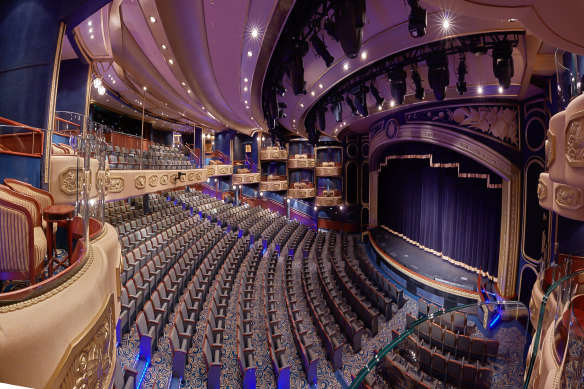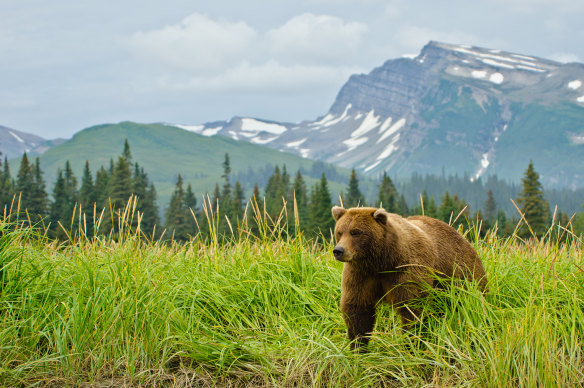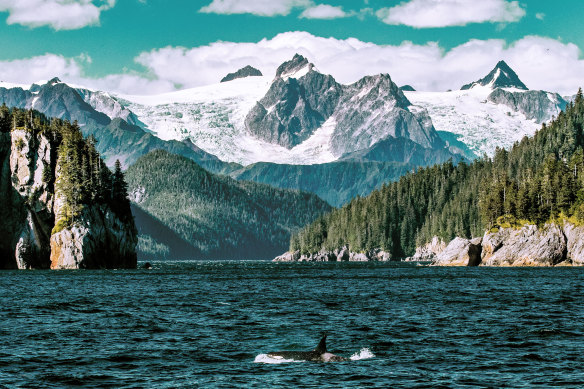This was published 1 year ago
The Alaskan glacier that makes Game of Thrones’ Wall seem feeble
Time ebbs and flows on Cunard’s Queen Elizabeth. As I enter the ship’s Grand Lobby, with its curved staircase, angular light fittings and tan-and-golden tones, I’m transported to the glamorous art deco era.

The Queen Elizabeth, dwarfed by ice in Glacier Bay, Alaska.
Or perhaps time feels warped because we’re following the ghostly wake of the SS Queen, a two-masted, 300-passenger steamship that sailed in the same waters in 1883. A newspaper reported, “Her elegance is known to all. Her electric lights, splendid furniture and gorgeous salon make her a floating palace.”
Exactly 140 years on, Queen Elizabeth is my buoyant castle. I’m one of 2000 passengers sailing the 10-day journey through Alaska’s Inside Passage, a remarkable 1600-kilometre-long network of fjords and forested islands. The return route from Vancouver will follow a rough figure-eight, with a detour northwards to Hubbard Glacier.
Our first day is at sea, so I enjoy exploring the ship’s 12 decks. Initially, given my lack of direction, I get lost often. My partner finally points out that the restaurants and bars are excellent orientation landmarks. He’s right. The main Lido dining buffet is on Deck 9, while on Deck 10 and overlooking the bow is the Commodore’s Club, a sophisticated piano bar with velvet seats around the curved bank of windows.
Near the Grand Lobby, The Gin & Fizz bar serves exclusively gin cocktails and champagne. There’s The Steakhouse at Verandah, a specialty grilled meat restaurant. And the Britannia Restaurant, the elegant dining room, is at the ship aft on Deck 2.

The Queen Elizabeth’s Royal Court Theatre auditorium.
But, as I determine, my inner-compass is awry if I head forwards on the same deck and reach the 830-seat Royal Court Theatre. Though this is the perfect place to wind up, especially in the evening when the Royal Court Theatre Company (or guest entertainers) dance and sing their way across the stage, even when the ship lurches, which it does one rough(ish) sailing in the Gulf of Alaska.
The theatre is also where Dr Rachel Cartwright, the ship’s energetic naturalist, enthralls us with her knowledge of South-East Alaska during the optional “Cunard Insights” sessions. I soak up the region’s “hows”. How the temperate rainforests comprise 1000-year old trees of Sitka spruce, Western hemlock and Alaska yellow cedar. How for thousands of years, the area has been home to the local Tlingit, Haida and Tsimshian nations. How glaciers, rivers of ice, have carved valleys as the ice pushes forward. How fjords are formed after glaciers retreat and tidewaters flood in. And how bears congregate around salmon runs (in other words – keep your eyes open for wildlife.)
By the time we approach Tracy Arm-Ford’s Terror Wilderness area, we’ve left behind the emerald-hued, old-growth forest. As we enter Tracy Arm Inlet, steep valleys of dark granite tower above us, punctuated by long, narrow waterfalls. When a passenger points and yells “there!” I grab my binoculars: clinging to a steep hillside is a large, black bear.
But what grabs our attention are the icebergs – blue and glowing, there are hundreds of these ghostly icebergs scattered in the waters, resembling a series of bobbing cellophane sculptures that radiate a cerulean shade. As we float through the prismatic wonderland the sun disappears, as if sensing its demotion.
The following days bring port calls. At Icy Strait Point on Chichagof Island we watch adrenaline-seeking guests as they scream their way down a zip line, a one-and-a-half minute ride that drops 400 metres over the rainforest. We then stroll along the waterfront to Hoonah, a small Tlingit community nearby.
On Baranof Island, we explore the town of Sitka, where the 18th century Russian legacy is reflected in the dome of the remarkable St Michael’s Cathedral. In Haines, we look (unsuccessfully) for moose that sometimes wander through the streets, thanks to the Chilkat River Corridor that allows them to migrate. It pours in Juneau, but we pull up our hoods and follow the recently-inaugurated Totem Pole Trail. Erected in April 2023, it showcases 13 exquisite totem poles made by master carvers from the region.
Meanwhile, many guests revel in the array of shore activities: wildlife watching and sea kayaking, fishing with Bering Sea crab fishermen and cultural walks. They return with stories of seafood feasts and snaps of seabirds and sea otters. I’m envious.
Since spotting the bear, I’ve missed many sightings. Or so I discover when I eavesdrop on those guests chatting with Rachel at her designated afternoon post; videos appear of breaching whales and Steller sea lions. Animals seem to materialise when I’m dining which, given the ship’s tempting, high-quality cuisine, is frequently. I update my diary entries to record (in brackets) my wildlife failures: sockeye salmon (orcas); flambeed Baked Alaska (humpbacks) and chicken Tikka Masala (porpoises). Then there’s the Commodore’s specialty cocktails (bald eagles and mountain goats).

Keep your eyes peeled for wildlife on shore.
But the foodie highlight, and one of Cunard’s signature treats, is the traditional afternoon tea. This daily 3.30pm ritual takes place in the Queen’s Lounge, where small tables are prepared ornately with cloths and crockery. Envisaging the Dowager Countess in Downtown Abbey, I’m tempted to stick out my pinkie (I resist, though I find myself sitting ramrod-straight, nonetheless). Staff in white jackets proffer silver trays that are laden with petit fours and scones and jam, and pour tea from large pots.
In the evenings, the lounge morphs into a stately ballroom where couples, many in sparkly attire, waltz across the dance floor, especially on the ship’s formal gala nights, such as the Ice White Ball.
The sun reappears for our arrival at Hubbard Glacier, one of only seven advancing glaciers in Alaska. Guests take to the decks to soak up nature’s glorious exhibit: a massive turquoise-and-white curtain, topped with pinnacles and pierced with crevasses, cracks that form as the ice flows.
But the crown jewel is Glacier Bay National Park and Preserve, 500,000 hectares of mountains, fjords and icefields. The entire ship seems to be awake early, there’s a palpable frisson. Heavy rain sets in so guests spread themselves around the ship, claiming a patch of fogged-up window in the likes of the Cafe Carinthia (decent coffee) and the Golden Lion pub (excellent beer).
Of Glacier Bay’s many magnificent glaciers, Margerie Glacier is the visitor magnet. This active glacier flows for 33 kilometres from the Fairweather Mountains before emerging at Tarr Inlet.
The Queen Elizabeth proceeds cautiously through the fjord, dwarfed by the gorge. Stark grey-granite rock soars above. Here and there, massive U-shaped valleys – former glacial tributaries – hang beneath the ridge lines. Below in the tidewaters, chunks of ice, the result of calving (when ice breaks off) and plunges into the sea, clink melodiously like wind-chimes.
Eventually, we’re facing Margerie Glacier. Its immense size makes The Wall in Game of Thrones seem feeble. And I’m astounded to learn that it’s over 7.5 kilometres away. The ship spins slowly around, providing all guests a chance to view it from their balconies. There is a hushed silence; nature has transformed us. And it doesn’t stop.
A family of orcas greets us in the harbour of Ketchikan, a frontier port known for the seasonal salmon run when, from a boardwalk viewpoint in the quaint and historic Creek Street, visitors can observe Pacific salmon battle their way up the creek. In the harbourside city of Victoria, Vancouver Island, we pedal our way to the glorious grounds of Government House, a surprising alternative to the island’s beautiful Butchart Gardens.

Orcas patrol the waters.Credit: iStock
But it’s always a delight to return to the ship, greeted by cheerful staff who create a seamless journey, ready with towels and extra glasses and restaurant reservations.
Which brings, or rather takes, me back to the 19th century. Describing her trip to Alaska aboard SS Queen in 1890, a passenger and diarist Septima Collis, said she found: “everything in apple-pie order, clean, neat, spacious, and thoroughly comfortable…”
She asserted that “…to those of us who are fond of travel and adventure this is a very important matter, for unless we find ourselves in a contented frame of mind, we are in no mood to appreciate the surroundings.”
My own conclusion? Different century, similar sentiment. At least when aboard the Queen Elizabeth.
THE DETAILS
CRUISE
Cunard’s ten-night sailing through the Inside Passage departing Vancouver on Queen Elizabeth (based on a June 2024 departure) starts from $2349 a person twin share. See cunard.com
MORE
Read The Naturalist’s Guide: Wildlife and Wilderness along Alaska’s Inside Passage by Rachel Cartwright
See travelalaska.com
The writer was a guest of Cunard Line.
Sign up for the Traveller Deals newsletter
Get exclusive travel deals delivered straight to your inbox. Sign up now.